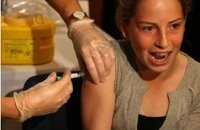25% of teen girls vaccinated for cervical cancer, U.S. says

Los Angeles, CA
The CDC calls the rate 'very good' for a new vaccine such as Gardasil. Earlier data show, however, that only about 1% of Latina teens have received it.
About a quarter of the nation's teenage girls received the controversial cervical cancer vaccine Gardasil last year in its first full year of distribution, federal authorities said Thursday.
"For a new vaccine, 25% is really very good," Lance Rodewald, director of the division of immunization services at the Centers for Disease Control and Prevention, said in a telephone news conference releasing the data.
"We need to see that rate every year if we are going to meet our goal" of having 90% of teenagers vaccinated, he said.
But immunologist W. Martin Kast of USC's Keck School of Medicine said, "Twenty-five percent is not bad, but it's not good either."
He said data released earlier in the year by Gardasil's manufacturer, Merck & Co., show that only about 1% of Latina teens were receiving the vaccine, and "they are the population that needs it the most" because the frequency of infection is relatively high.
Researchers said the percentage of teens receiving two other relatively new vaccines also went up. About 32% of teenagers received the meningitis vaccine, up from 20%; and 30% received the tetanus, diphtheria and whooping cough vaccine, up from 19%.
CDC recommends that girls get the cervical cancer vaccine and that all children get the other two when they are 11 or 12.
Merck received Food and Drug Administration approval to begin marketing Gardasil in June 2006. Experts say it spent $100 million marketing it in 2007 and had sales of about $1.5 billion.
The vaccine protects against four strains of human papilloma virus that account for about 70% of all cases of cervical cancer in the United States.
But the vaccine has been criticized on a number of fronts. Some scientists argue that it is only modestly effective and that its safety has not been adequately proved. Conservative groups say that giving it to young girls implies approval of sexual activity. And consumer advocates bemoan its high price -- $360 for a series of three shots.
The data, published in CDC's Morbidity & Mortality Weekly Report, came from the second year of the agency's annual National Immunization Survey for Teens. Researchers conducted telephone interviews with a representative sample of nearly 3,000 teens ages 13 to 17, then confirmed their answers with vaccination records from physicians.
They found that 25.1% of girls in the group had received at least one dose of the vaccine, which translates to about 2.5 million of the country's 10 million girls. Only a quarter of that group had received all three recommended doses, but officials noted that the series takes six months and many girls had not had time to complete it.
Results are unlikely to be as good this year, however. Merck reported sales were down 9% in the second quarter, and IMS Health Inc., which monitors drug use, said U.S. sales were off 34% in July and August, probably as a result of the faltering economy.
Labels: Cervical Cancer Prevention, Cervical Cancer Vaccine, Gardasil

0 Comments:
Post a Comment
<< Home